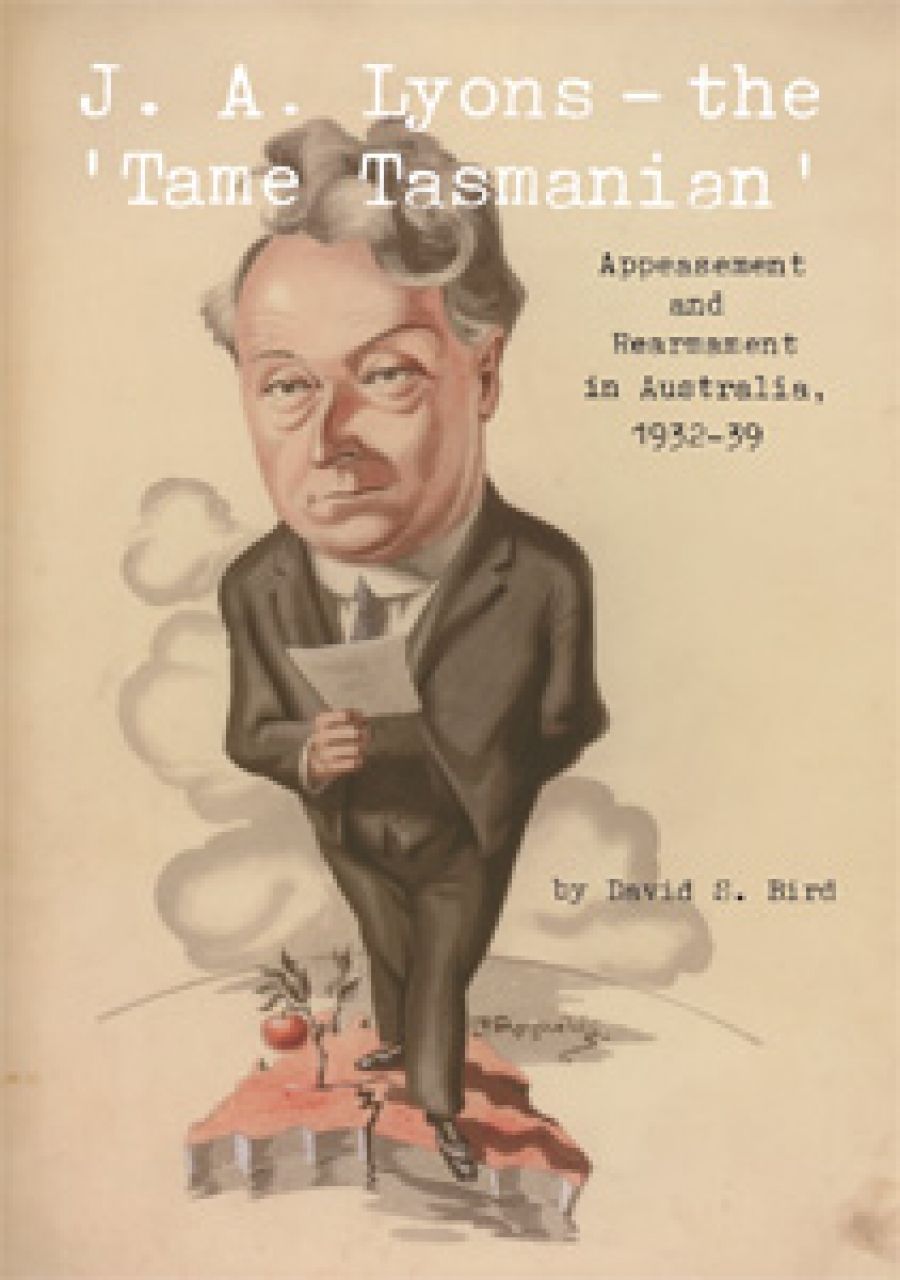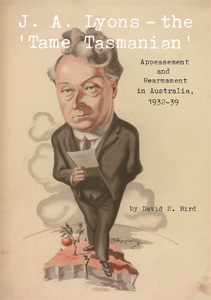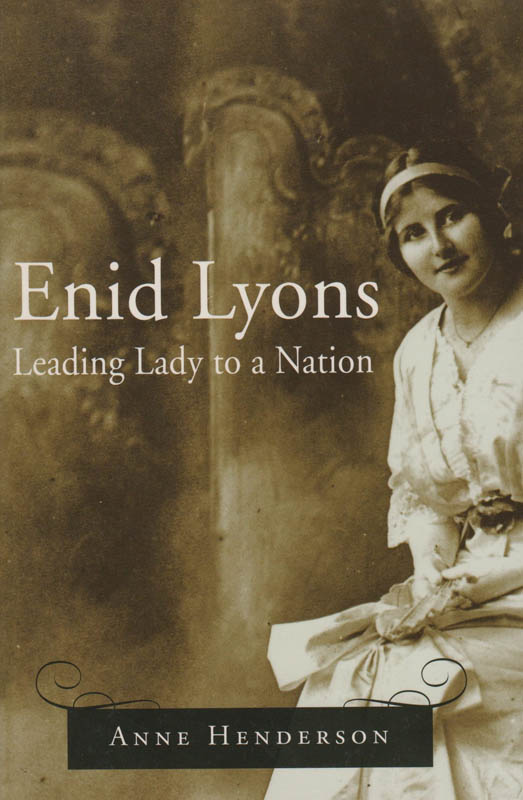
- Free Article: No
- Contents Category: Biography
- Review Article: Yes
- Article Title: The Lyons den
- Online Only: No
- Custom Highlight Text:
Literature is full of unexpected coincidences. After a long silence, two books appear within a matter of months that present both a detailed, personal and a deeply investigative account of those unique political partners, Joseph and Enid Lyons.
- Book 1 Title: J.A. Lyons – The ‘Tame Tasmanian’
- Book 1 Subtitle: Appeasement and rearmament in Australia, 1932–39
- Book 1 Biblio: Australian Scholarly Publishing, $39.95 pb, 443 pp
- Book 1 Cover Small (400 x 600):

- Book 1 Cover (800 x 1200):

- Book 2 Title: Enid Lyons
- Book 2 Subtitle: Leading lady to a nation
- Book 2 Biblio: Pluto Press Australia, $29.95 pb, 356 pp
- Book 2 Cover Small (400 x 600):

- Book 2 Cover (800 x 1200):

Some doubt exists about Enid’s paternity, but, educated at Burnie Public School, she drew greatly from the influence of a strong mother, ‘a natural Fabian’, a Methodist steeped in the ethos of hard work and temperance who entertained at her dinner table a range of working men from Tasmania’s Laborite mining and timber towns, whose opinions in turn shaped the thinking of her receptive daughter. It was through the enterprising Eliza that Enid, just fifteen and working as a trainee teacher at Burnie, met Joseph Lyons, the local member for Wilmot and Tasmanian minister for education. A former teacher himself, an active education reformist, Joe was both a devout Catholic and a devoted, unmarried son. He fell deeply in love with the beautiful and confident young girl and, after a torrid exchange of letters, they married when Enid turned seventeen. Joe was thirty-five.
Despite a scent of scandal, Enid readily converted to Catholicism. ‘Was man ever blessed as I am without deserving it, or was any man happier than I am today?’ Joe wrote her at that time in one of many intimate letters that flowed to her as they managed their often geographically separated political lives, and which, shortly before her death, Enid donated to the National Library. Together, the Lyons bred a large family of twelve children (two died in childhood) and mixed Joe’s leadership career and Enid’s rising prominence as his politically savvy wife with commitments in Canberra and Tasmania. During Joe’s prime ministership (1932–39), they bridged a critical time in Australia’s history. His sudden death from a heart attack in April 1939, at the age of fifty-nine, ‘stopped a nation’.
Recovering in time from this exacting trauma, Enid stood for federal parliament in the election of 1943 and served for eight years as member for the Tasmanian seat of Darwin (now Braddon), where she effectively represented the life and challenges of suburban women, consolidated her reputation as an articulate broadcaster and newspaper columnist, rose to become a member of Robert Menzies’ cabinet, without a portfolio as Vice-President of the Executive Council, and was a voice to be reckoned with. Henderson has been well served by Enid’s memoirs, So We Take Comfort (1965) and Among the Carrion Crows (1972), and clearly shares many of her values. Not surprisingly, she dismisses the stereotyping of her subject by several contemporary male parliamentarians (including Earle Page and Menzies) as an ‘ambitious and manipulative wife’. Enid’s commitment and courage and her considerable talent shine through this informative and well-written biography. The tale of her close friendship with Larry Anthony adds a disarming touch.
Enid Lyons’s strong influence on her husband and his role in the policy of appeasement in the 1930s, discussed by Henderson, also emerges clearly in David S. Bird’s substantial book. Bird’s mission is to challenge the myth that Joseph Aloysius Lyons was ‘inept, bumbling and out of his depth’ in the international arena, and that he was an ‘appeaser of fascists’. His aim is to deconstruct the purely negative connotation of appeasement, that has grown up in historical writing since World War II, and to interpret Lyons’s thinking and style of leadership in foreign policy during those dangerous years.
Having left the Labor Party to join the newly formed United Australia Party and become its leader and first prime minister, Lyons’s focus was primarily economic: to retrieve the country from the ravages of the Depression, to lower the high rates of unemployment and to foster trade. But it also fell to this gentle, uxorious man to be thrust into the maelstrom of international crisis and negotiation. Lyons himself had not fought in World War I but, as a firm anti-conscriptionist and pacifist, he believed that the world had not recovered from that murderous war or from the harshness of the Versailles peace treaties. With a natural inclination to ‘consultation, concession and compromise’ in his domestic domain, he saw appeasement as the instrument through which he might extend consensus in the international arena and become a ‘peacemaker’. So it is as an active participant, rather than as a supine associate in the British policy of appeasement, that Bird presents ‘the Tame Tasmanian’.
In Bird’s detailed scrutiny of Australia’s evolving foreign policy, Lyons’s trajectory makes arresting reading. In 1932–33, with Australian trade interests firmly in mind, he successfully stood out against Britain’s proposal for sanctions against Japan’s incursions in Manchuria. With Enid beside him in 1935, he made his first visit to London, forming a close association with Neville Chamberlain, then a member of Stanley Baldwin’s government, and forging the close bonds for his enduring endorsement of ‘the Chamberlain tradition’. Travelling to Europe, Lyons pursued a policy of ‘personal diplomacy’, setting up a meeting with Adolf Hitler in the Rhineland, from which, at the last moment, the chancellor annoyingly extricated himself. In 1936 Lyons met Benito Mussolini in Rome and expressed his enthusiasm for the new Italy and its dictator, ‘a man’, he declared publicly, ‘who has done immense good’. With Italy’s subsequent invasion of Abyssinia, Lyons stalled for time but was eventually obliged to follow imperial policy and British sanctions.
En route to England in 1937 for George VI’s coronation and the Imperial Conference, he stopped off in Rome for a second meeting with Mussolini, at which he was at pains to persuade the Duce of Britain and Australia’s friendly feelings. In London he espoused his proposal for a Pacific Pact of ‘world appeasement and peace’, which would also recognise Japan’s seizure of Manchukuo.
Lyons’s contribution to Chamberlain’s policy of appeasement by negotiation took positive form in 1938. Having agreed with British recognition of the Anschluss in April 1938, and having made clear Australia’s readiness to concede the Sudeten Germans in Czechoslovakia to Germany in the interests of conciliation, Lyons was overjoyed at Chamberlain’s decision to visit Hitler at Berchtesgaden. Importantly, as the situation worsened in September 1938, both for Czechoslovakia and for peace, Lyons took the initiative (Enid claimed authorship of the idea) of both cabling and telephoning Chamberlain, urging him to make a personal appeal to Mussolini to curb his Axis partner and to use Australia’s high commissioner in London, Stanley Bruce (the former prime minister), as an intermediary. While never publicly acknowledged by Chamberlain, Bird argues that this background thrust towards the Munich Pact justifies Lyons’s claim to have ‘played a part in this so critical period’. Yet his hopes as a world peacemaker were short-lived, and the strain of his involvement in the foreign tensions of the annus horribilis of 1938 was clearly a contributing factor in his sudden death early the following year.
‘Honest Joe’ Lyons emerges from this study as a more dominant and complex character than is generally believed. His personality and faith that world peace could be gained at any cost dominated Australia’s external affairs, stifled opposition, and weakened consultation with Cabinet colleagues who, in the main, did not share his total commitment to universal, as opposed to regional, appeasement. In all these activities, Lyons conducted himself with a marked degree of secrecy. Here he appears to have had much in common with Chamberlain, his British counterpart, who ran one of the most authoritarian and secretive governments in a peacetime Britain. Lyons was a foreign policy control man, offering a minimum of public statements and keeping the public uninformed. His technique of over-simplification or rhetoric in conveying foreign policy developments to parliament and the people obscured government actions, and was recognised and eventually resented by the press.
Yet within the ambit of imperial policy, Lyons fought consistently, if not always successfully, for a larger role in consultation with Britain in policy-making. Particularly after the Imperial Conference of 1937, he never lost his sense that the diplomacy of appeasement had to be supplemented with military muscle. If his thinking was shaped initially in terms of an integrated approach to cooperation in ‘strategic Imperial and local defence’, Lyons perforce came to accept the need for local action, strengthening Australian rearmament in 1937–38 to reach the highest annual expenditure on defence in the peacetime history of the Commonwealth.
Bird’s highly detailed and heavily endnoted book bears all the marks of a doctoral thesis. Nonetheless, it is important to have this dense material on record. Readers, however, should be warned of its unsatisfactory index.
‘Neither you nor I,’ Lyons wrote in April 1939, in one of his last letters to his wife, ‘can put everything right and we saved Australia from ruin. Think of the homes that are happy because of what we did.’ Here, indeed, writes Bird, was ‘a peacemaker let loose in the lion’s den of his time’.


Comments powered by CComment